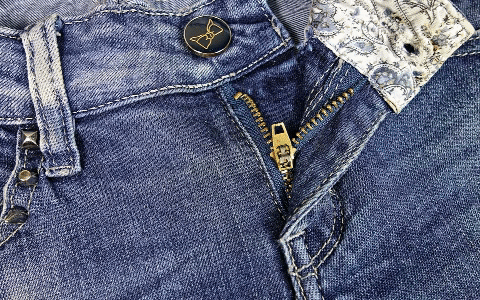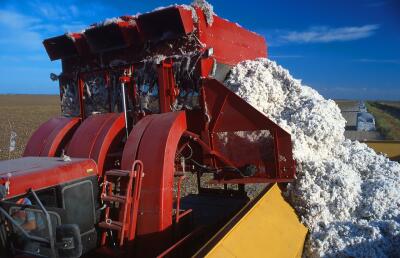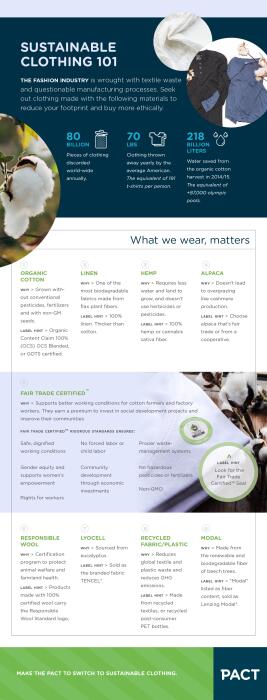Lessening the Harmful Environmental Effects of the Clothing Industry

When people think of pollution, they typically think of CO2 emissions, also known as greenhouse gases, coming from large industrial plants and highways clogged with vehicle traffic. What many people don't realize is that one of the biggest pollutants of our environment can be found in their closets - clothing, shoes, and other textile accessories.
Clothing is the second largest pollution source in the world. Pollution from clothing starts well before an old T-shirt is tossed in the trash. Textile pollution happens throughout the entire production of products, starting as far back as the farming process. For example, conventional farming for fibers like cotton relies on heavy pesticide use, while manufacturing synthetic fabric relies on the use of non-renewable energy sources, like crude oil. Finally, disposed textiles that wind up in landfills lead to greenhouse gas emissions and toxins leaching into the surrounding soil and water.
The good news is that there are hardworking individuals, companies, and organizations working to minimize the damage to our environment throughout the entire lifecycle of textile production and use. As a consumer, there are many steps you can take to reduce your personal impact on textile use and waste, while advocating for and promoting environmentally responsible businesses and organizations.
Educate: Improving the Farming Process for Textiles
 To illustrate the importance of understanding how farming affects the textile industry, let's discuss one of the most important textile fibers in the world - cotton.
To illustrate the importance of understanding how farming affects the textile industry, let's discuss one of the most important textile fibers in the world - cotton.
Of the world fiber use, cotton averages about 25% of total use. Cotton is grown globally, too, with China, India, and the United States being the largest producers of cotton. Some cotton is considered conventionally farmed, meaning it's grown using pesticides and synthetic fertilizers, while toxic chemicals aid in harvesting. All of these processes expose agricultural workers to dangerous chemicals, on top of the numerous dangers they face regularly.
Thankfully, cotton can also be farmed using organic processes. Organic cotton saves farmers and the environment from toxic chemicals by using natural ecological processes and the local environment to grow and harvest the crop. Beyond saving farmers and the environment from the use of harmful chemicals, organic cotton farming has the potential to save farms 218 billion liters of water and 288.7 million kilowatts of energy, among other benefits.
Today, there is a growing need to bring supply chain transparency to the textile industry to promote responsible farming, manufacturing, and fair treatment of workers and animals. Certifications like Fair Trade and Global Organic Textile Standard (GOTS) help hold the cotton industry responsible for organic production standards and treating their workers fairly. Consumers can find Fair Trade and GOTS logos on labels of clothing to help spot ethically-made clothing.
Eliminate: Clothing Companies Are Sourcing Organic Cotton
Today, companies understand the effects that textile pollution has on the environment. Consumers are also realizing they play a big role in the problem of textile pollution by buying fast fashion styles: clothing that is mass-produced in large quantities to be more affordable and purchased more frequently. Typically, fast fashion styles aren't made to last long in a consumer's closet either. Low-quality clothing means consumers will shop more often and toss more clothes in the trash.
However, there are a lot of companies taking bets against fast fashion and making high-quality products that are produced with high ethical and environmental standards. Companies like PACT, an organic clothing company, have published a mission to create comfortable clothes without putting people and the earth in danger. To do this, PACT uses Fair Trade factories and sources organic fibers like organically-grown cotton to make their comfortable clothes for men, women, and children.
Donate: Understand the Impact of Recycling Clothing
In the United States alone, more than 15 million tons of textile waste is generated, with the average American tossing out approximately 80 pounds of clothing.
This amount of waste has detrimental effects on our environment. While some clothing is donated and recycled, the majority of textile waste heads to our landfills where they release greenhouse gases and leach toxins and dyes into the surrounding soil and water. However, there are many individuals and organizations, like Planet Aid, working to reduce the amount of textile waste heading to landfills.
Planet Aid's conveniently located bins help to reduce landfill waste and to promote recycling. Not only do our bins help contribute to the betterment of the environment, but the proceeds from our clothes collection go toward funding sustainable development projects in some of the poorest areas of the world, helping to build better, more sustainable communities.
How Consumers Can Make a Change
Consumers have the power to help make a difference simply by changing how they shop. Check out these simple tips for how to adopt environmentally-friendly shopping habits:
1. Research the standards of clothing companies
Use sites like Know the Chain and Fair Trade USA to find out where brands make their clothes, how they treat their workers, and if they have allegations against the working conditions of the factories where their clothes are made.
2. Shop consignment stores
Many consignment and thrift stores are full of quality secondhand clothing. Shopping secondhand stores means fewer clothes are headed to the landfill.
3. Shop homemade stores
Check out stores on Etsy and other small boutiques with locally handmade clothing to support the local area and small businesses instead of supporting large retail stores that don't ethically source their clothing.
This blog was contributed to Planet Aid by Meghan Stripe, an environmental advocacy researcher, and writer within the fashion industry. For this post, Planet Aid added some research findings on "fast fashion" within the textile industry.


